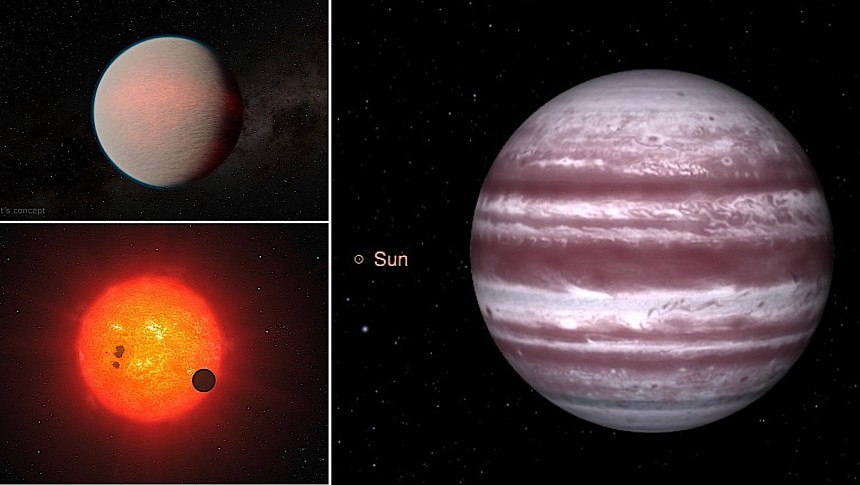40 light years away from Earth, circling a small star in the constellation of Ophiuchus, there's a super-Earth called Gliese 1214 b. Also known as GJ 1214 b, it was discovered in 2009 and has been a favorite object of study for astronomers ever since. But only now, thanks to the James Webb Space Telescope (JWST), do we get to learn some of its secrets.
GJ 1214 b is part of a family of planets that are also called mini-Neptunes. That's because they have a rocky composition, possibly oceans above that, and an atmosphere rich in hydrogen. These things are, technically, the most common kinds of planets in our galaxy, but just to rub our face in it, the Universe didn't see fit to create one in our solar system as well.
What the absence of a mini-Neptune from the neighborhood means is that, at the moment, there's little we know about them. Well, we know a little more now that Webb helped us get the closest look yet at such a "mysterious world," as NASA calls it.
Previous observations of GJ 1214 b allowed human astronomers to see there's a haze or cloud layer going around the entire planet. It was unclear what that was, because current instruments didn't allow closer observation.
Webb and its Mid-Infrared Instrument (MIRI) changed that, as it allowed, for the first time, a clear look at the atmosphere as it presents itself all over the planet. That's right, all over the planet, as the telescope tracked the thing for the duration of its orbit around the star.
This allowed a team from the University of Maryland, led by Eliza Kempton, to form a pretty good idea of not only the planet's atmosphere, but also about its past.
The first secret the planet shed when exposed to Webb's instruments is that its steamy atmosphere may contain a lot of water, in the form of clouds and steam. Astronomers found a temperature shift between the day and night side of the planet from 535 to 326 degrees Fahrenheit (279 to 165 degrees Celsius), and that can also be explained by the presence of heavy molecules of water or methane in the atmosphere.
It's of course not clear how water got up there, but the team behind the study, which was published in Nature, speculate that sometime in its past the planet might have had liquid water oceans and seas.
Despite being too hot for us humans to be able to visit unprotected, GJ 1214 b is less so than expected, and that is owed to the same atmosphere, which reflects light back into space instead of letting it through to warm the surface. This process also makes the planet highly reflective, shining bright before our instruments.
This being the first time we were able to study a mini-Neptune in such detail makes scientists confident we'll soon get a better understanding of this kind of world, so present in our galaxy yet so elusive to us.
What the absence of a mini-Neptune from the neighborhood means is that, at the moment, there's little we know about them. Well, we know a little more now that Webb helped us get the closest look yet at such a "mysterious world," as NASA calls it.
Previous observations of GJ 1214 b allowed human astronomers to see there's a haze or cloud layer going around the entire planet. It was unclear what that was, because current instruments didn't allow closer observation.
Webb and its Mid-Infrared Instrument (MIRI) changed that, as it allowed, for the first time, a clear look at the atmosphere as it presents itself all over the planet. That's right, all over the planet, as the telescope tracked the thing for the duration of its orbit around the star.
This allowed a team from the University of Maryland, led by Eliza Kempton, to form a pretty good idea of not only the planet's atmosphere, but also about its past.
The first secret the planet shed when exposed to Webb's instruments is that its steamy atmosphere may contain a lot of water, in the form of clouds and steam. Astronomers found a temperature shift between the day and night side of the planet from 535 to 326 degrees Fahrenheit (279 to 165 degrees Celsius), and that can also be explained by the presence of heavy molecules of water or methane in the atmosphere.
It's of course not clear how water got up there, but the team behind the study, which was published in Nature, speculate that sometime in its past the planet might have had liquid water oceans and seas.
Despite being too hot for us humans to be able to visit unprotected, GJ 1214 b is less so than expected, and that is owed to the same atmosphere, which reflects light back into space instead of letting it through to warm the surface. This process also makes the planet highly reflective, shining bright before our instruments.
This being the first time we were able to study a mini-Neptune in such detail makes scientists confident we'll soon get a better understanding of this kind of world, so present in our galaxy yet so elusive to us.






